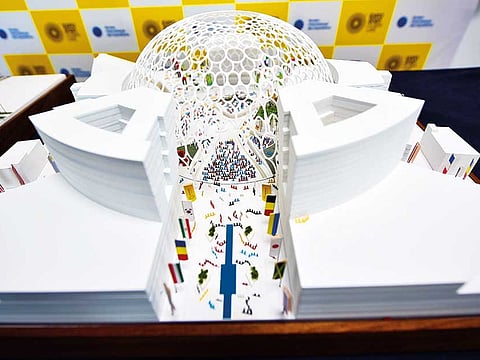Expo 2020 Dubai unveils design for central hub
Al Wasl Plaza to be built to LEED Platinum sustainability standards

DUBAI
Monday saw the unveiling of the design for 10,000-person capacity central hub for Expo 2020 site, Al Wasl Plaza. It was revealed by Ahmad Al Khatib, Vice President of Real Estate at Expo 2020 Dubai.
The plaza — the last major design element of the Expo project to be revealed — will be covered by a translucent 360-degree projection dome made from heat-resistant materials to help cool the plaza as well as display videos.
Al Khatib declined to give an estimated cost for the 150m-diameter plaza, saying that information would be released after the tendering process was complete and the contractor selected.
Al Wasl — Arabic for Connection — Plaza will be the central hub linking Expo 2020’s three thematic hubs, covering mobility, sustainability and opportunity.
The 65m-high, 130m-diameter trellis-like dome is designed to replicate Expo 2020 Dubai’s logo from above. At night, it will act as a 360-degree projection screen, with projected images visible both inside and outside the dome.
“This is a space that at once reflects the heritage of our country and its vision of a future where nature and technological innovation are integrated in a sustainable way,” Al Khatib said.
The plaza, designed by Chicago-based Adrian Smith + Gordon Gill Architecture, will be built to Leadership in Energy and Environmental Dersign (LEED) Platinum sustainability standards, the highest LEED rating, with passive cooling supplemented by active district cooling when necessary.
Passive cooling will use natural breezes, combined with heat-reflecting materials and paints. The result, Al Khatib said, would be a temperature that was “cosy and comfortable” for visitors.
“In addition we are using renewable energy, and efficiency of design will work in a great way to reduce energy,” he said.
All buildings at the Expo site would be built to LEED Gold sustainability standards, with some — not only Al Wasl Plaza, but the UAE Pavilion as well — built to LEED Platinum standards. he added.
As with other buildings on site, it has been designed to be useful after the end of Expo 2020. Al Khatib suggested it could be used for key events such as National Day celebrations.
“The plaza has been designed to use the whole surface,” he said, “either for a single event of up to 10,000 people or a series of events simultaneously.”
Expo 2020 will have two road links and a Metro line, currently under construction, linking it to Al Maktoum International Airport and to the existing Metro Red Line near Ibn Battuta Mall.
The Expo site will recycle sewage water and grey water from showers and sinks for irrigation. It will also harvest water from humidity. Al Khatib said the moisture extraction would certainly be used for irrigation, but Expo 2020 Dubai was also investigating how the extracted water could be treated to provide fresh drinking water.
Following Al Khatib’s briefing, journalists were given a tour of the Expo site, where site levelling has been completed and underground infrastructure is currently under construction.
The entire infrastructure for the site is due to be completed by July 2018, with all construction due to be completed by October 2019, a full 12 months before Expo 2020 is due to open — it’s scheduled to run from October 20 2020 to April 10 2021.
Once the Expo is finished, the buildings surrounding the plaza will be converted to hotels and commercial space.
“Every single facility will be maintained and will be used after Expo,” Al Khatib said. “We have a team studying the post-Expo phase and we have [designed] buildings to be useful after Expo.”
Sign up for the Daily Briefing
Get the latest news and updates straight to your inbox



